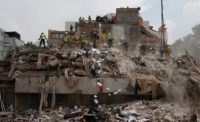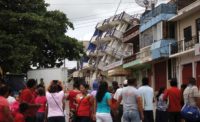In the wake of Sept. 19’s magnitude-7.1 earthquake that killed at least 369 people in Mexico, geotechnical engineers are calling for routine site-response analyses during design to ensure structures in high seismic zones are not “in tune” with their soil. Much of the damage to some 1,000 buildings—and the majority of the 44 collapses—in Mexico City was a consequence of the dangerous alignment of the resonant frequencies of the quake, the soil and the buildings—a known hazard well beyond Mexico, say the experts.
Every city in a high seismic zone is at risk, says geotechnical engineer Kevin W. Franke, a Brigham Young University professor of civil engineering. “We do not want our structures to be in tune with the soil.”
To mitigate the hazard, seismic engineers need “to pay more attention” to the resonant frequency of a structure and its soil, Franke advises. But he laments that site-response analyses to determine a soil’s resonant frequency are only performed for critical or expensive structures. He wants the practice to extend to ordinary buildings.
From Sept. 24 to Sept. 30, Franke led a reconnaissance team to study ground effects of the quake. The trip was the first of two organized by the Universidad Nacional Autonoma de Mexico (UNAM) and the Geotechnical Extreme Events Reconnaissance Association (GEER) and sponsored by the U.S. National Science Foundation.
UNAM-GEER teams collected and documented perishable data. They currently are developing case studies, which will be useful to researchers and practitioners when evaluating engineering models and analysis tools, says Tara C. Hutchinson, a professor of geotechnical engineering at the University of California, San Diego. Hutchinson led the second Mexico trip, from Sept. 29 to Oct. 6.
Franke stresses that every site has a resonant frequency, whether it be lake-bed soil or glacial till. “We have this belief that site response is only a problem with soft soil, but that is not true,” he says.
If a quake happens to hit at the same frequency content of the soil, it’s going to amplify the shaking. If structures are also in tune, they will shake harder. “Even small intensities can be enormously amplified if everything is in tune,” Franke says.
Its epicenter 120 kilometers southeast of Mexico City, the Sept. 19 quake had a 0.6-second to 0.9-second period. Most damage was in a 20-km by 7-km area in the western-southwestern section of Mexico City—in the transition zone between the rocky hills and the former lake bed, with soft clay soils. Transition-zone soils have 0.7-second to 1.3-second periods.
The majority of the collapsed buildings were five to eight stories and neither critical nor expensive. The buildings had a natural period of 0.8 to 1.5 seconds—in tune with their soils and the quake.
In Mexico City, however, a site-response analysis during design—to ensure a building and its soil are not in tune—is no guarantee of avoiding resonance down the road. Buildings are settling at an average annual rate of 10 centimeters due to groundwater extraction. That consolidates the soils, which changes their properties and periods, says Juan M. Mayoral, a professor of engineering at UNAM.
Taking this consolidation into account, anticipated subsidence should be factored into the design of all new buildings, adds Mayoral. “We need to know the current period and the rate of change,” he says.
Hutchinson says it is also important to consider another moving target: Over time, as communities grow with more development, clay soils consolidate, too, affecting the rate of change of subsidence.
At first, if the soil is loaded by a new building, the load will go into the groundwater, which is not compressible. But if the water is drained over time, there is a problem, Hutchinson says.
Initially, “we think we know the soil’s elevation, levelness and strength, but we really don’t” because it can change, depending on other factors, she adds.
Preconstruction site soil improvement can increase the rate of consolidation dramatically—for example, getting the 1 in. or 2 in. of expected long-term settlement to happen in six months, says Hutchinson. But soil improvement is an extra cost.
The most recent damage may have been triggered by site amplification effects, but it was exacerbated by damage gone unfixed—due to corruption, among other reasons—from the city’s Sept. 19, 1985, magnitude-8.1 quake, Mayoral says. “We need to spend more money on the enforcement of the building code,” he adds.
In the quake, foundation performance varied considerably in areas of structural damage. End-bearing piles generally performed well, with occasional settlements ranging from 3 cm to 8 cm in the ground or hardscape surrounding the structure, says the first version of the GEER report on the first team’s investigation, edited by Mayoral, Hutchinson and Franke. (A second version is due out in a few weeks.)
Many structures on friction piles with mat foundations did not perform well. “There were observed cases of permanent structural tilt,” says the Oct. 16 report.
Many of the tilted buildings did not show signs of structural distress. The first team did not address whether the observed damage was due to the Sept. 19, 1985, magnitude-8.1 Michoacan quake or the Sept. 19, 2017, quake or both.
The first team also saw extensive ground deformation near the city’s southern rim. Settlement was as deep as 50 cm, with widths from 15 meters to 25 m. The bands extended over several city blocks, passing beneath structures and damaging several pipelines. The quake worsened some existing settlement, but there were also new cracks, the report observes.
The 2017 event was an intraslab subduction-zone quake. The temblor occurred at a depth of 57 km as a normal faulting mechanism near the point of maximum curvature of the Cocos plate, which is being subducted beneath the North American plate.
The 1985 and 2017 quakes were similar but had different periods. Available ground-motion records indicate a much higher frequency content in the 2017 event than in the 1985 quake.
The 1985 quake had a predominant period of 2.0 seconds. Major damage was concentrated in the central and northwest parts of the city. Buildings from eight to 15 stories, most with 2.0-second periods, suffered the most damage.
For all construction in high seismic zones, Hutchinson emphasizes that seismic engineers should pay more attention to ground conditions during design, even though the benefits may not immediately reveal themselves. She notes that, “typically, the investment in the geotechnical engineering component of a large construction project is small—on the order of 5% to 10% of the entire design and construction budget.”






Post a comment to this article
Report Abusive Comment